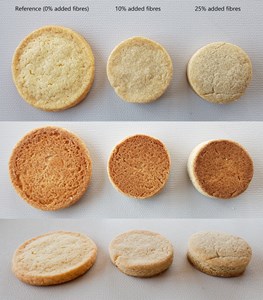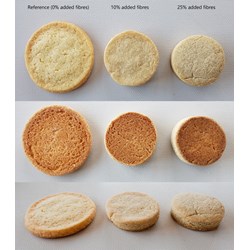Forced Belgian endive roots were washed to remove dirt and debris after that the head (the comestible part of the Belgian endive) was manually removed by cutting it away. The Belgian endive root was then diced into small fragments using an industrial mixer (robot coupe CL50 Ultra) to obtain small pieces of about 2.5 x 2.5 mm. The roots were then soaked in a boiling kettle (FIREX) with warm water at a temperature of 60 °C for 3 hours. The water was refreshed every hour. This was done to wash out the sugars and bitter substances of the product. After this step, the remaining product was dried in a multifunctional cabinet dryer (JUMO Imago F3000) at a temperature of 60 ˚C for four hours, reducing the moisture content to less than 10%. Once dried, the roots were processed into a powder using a Retsch ZM200 grinding mill equipped with a 0.5 mm sieve mesh. Cookies with Belgian endive powder were baked using a classic sand cookie recipe. Part of the flour has been replaced by the Belgian endive root powder (0%, 10%, 25% and 50%). The cookie with 0% Belgian endive root powder served as the reference. The cookie that most closely matched the reference (10%) was compared visually and by taste. To assess whether untrained consumers could notice a difference between the reference cookie (0%) and the cookie with Belgian endive powder (10%, 25% or 50%), an analytical sensory study was conducted.


The cookie that contained 25% endive fibres was very crumbly and easily fell apart after baking. It also showed many fissures and cracks. The unbaked dough itself was very crumbly resulting in great difficulties to roll out the dough and form the cookies. Because of the high fibre content, the cookies better retained their initial form which in a less broad and higher cookie after baking. Compared to the reference cookie there was also a difference in colouration, with fibre-rich cookies appearing more faded compared to the reference cookies. The cookies with addition of 10% fibres had an appearance in between the reference and the ones with 25%. Although the cookies didn’t fall apart due to too much crumbliness, some cracks and fissures could be detected by the naked eye after baking. The cookies retained better their initial shape compared to the reference, but still less than the cookies with 25% fibres. Additionally, because the cookies with more fibres kept their shape and didn’t flatten as much as the reference cookie, the underside also became much darker during the baking, as the heat of the oven plate was distributed over a smaller surface area. Based on these results, it was decided to test the cookie with 10% Belgian endive powder in the sensory study.